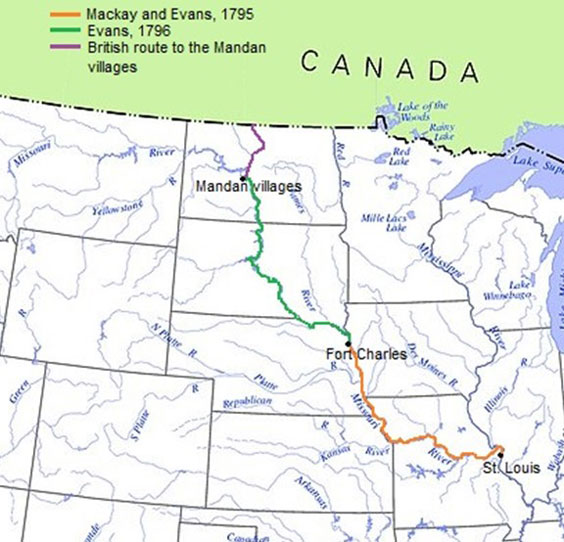When the Spanish Flag Flew in North Dakota: John Evans’ 1796 Expedition
As a seasonal interpreter at the Lewis & Clark Interpretive Center in Washburn, I get to share the history of the Lewis and Clark Expedition’s stay among the Mandan and Hidatsa peoples during winter 1804-5. Most visitors, however, do not know that an expedition eight years prior also came up the Missouri River and wintered among the Mandans. That expedition was led by John Evans, who was exploring for Spain.
In 1795, Spanish officials heard about a British fort among the Mandans, technically in Spanish territory at the time, with an “English flag” flying, according to fur traders who were there, though they probably meant a British flag given the colonial context. Spain hoped to get rid of the British by sending Spanish subjects up the Missouri River to deport the intruders. Spain also dreamed of building a line of forts from the upper Missouri all the way to the West Coast as a barrier against British or American invasions from the north or east. The governor of Spanish Louisiana offered a reward of 3,000 pesos to whoever could first reach the West Coast via the Missouri River.
Answering the call were James Mackay and John Evans. Mackay and Evans, who were Scottish and Welsh, respectively, but had become naturalized Spanish subjects, departed from St. Louis with 30 other men around September 1795. After wintering among the Omaha people in today’s Nebraska and setting up a trading post named Fort Charles, Mackay sent Evans ahead to the Mandan villages. Evans was charged with deporting the British fur traders, and if he had enough supplies and men, proceeding all the way to the Pacific Ocean and back. Evans also hoped to find out whether the Mandans, as some said, were descendants of pre-Columbian Welsh settlers. (He determined they were not.)

Routes to the Mandan villages in North Dakota taken by the Mackay-Evans expedition and the British. Wikimedia Commons, with trails added by author
Evans set out on June 8, 1796. He reached the Mandan villages on September 23 of that year and found some temporarily unoccupied British trading posts. The Mandans and Hidatsas in the area warmly greeted Evans and accepted the Spanish flags and medals he gave them. He soon took down the British flag from one of the trading posts and hoisted a Spanish flag instead.

John Evans likely hoisted this design of the Spanish flag over the trading posts at the Mandan villages. A portrait of King Charles IV of Spain was likely on the front of the peace medals with the phrase “al merito” (“to merit”) on the back. Wikimedia Commons
When fur traders came back from the north in early October, relations between them and Evans were cordial at first. Tensions flared in March when British trader René Jusseaume, who would later become an interpreter for Lewis and Clark, tried to kill Evans twice before returning north. (Jusseaume thought he could maintain British trade with the Mandans by getting rid of the man trying to halt it.) The British fur trade among the Mandans stopped while Evans remained with the Mandans. With the British fur traders out (for now) but lacking enough men and supplies to proceed west, Evans returned to St. Louis in July 1797. Thus ended the only Spanish-sponsored expedition to the Mandan villages.






